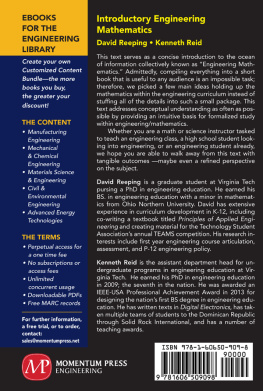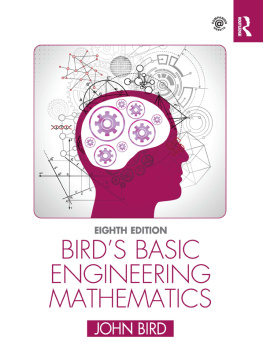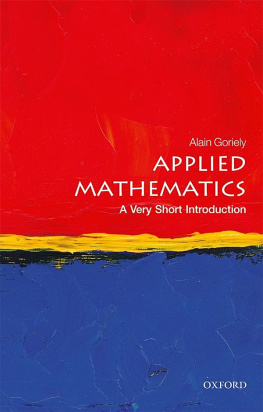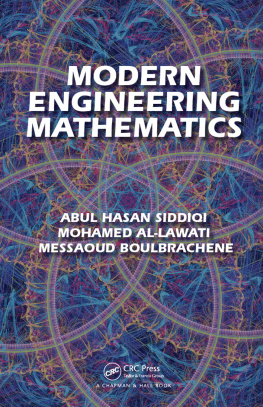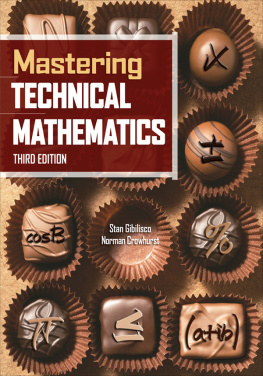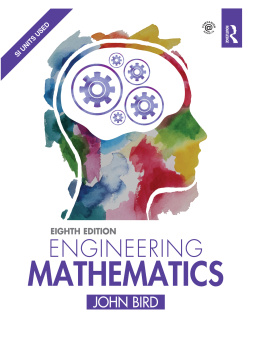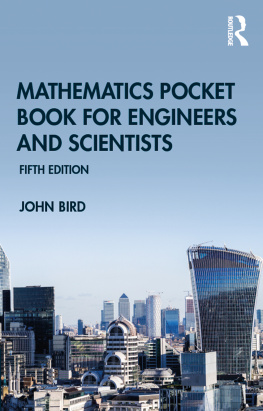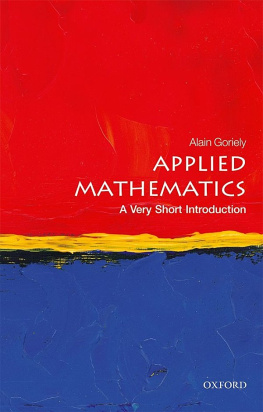INTRODUCTORY
ENGINEERING MATHEMATICS
INTRODUCTORY
ENGINEERING MATHEMATICS
DAVID REEPING
AND
KENNETH REID

Introductory Engineering Mathematics
Copyright Momentum Press, LLC, 2017.
All rights reserved. No part of this publication may be reproduced, stored in a retrieval system, or transmitted in any form or by any meanselectronic, mechanical, photocopy, recording, or any otherexcept for brief quotations, not to exceed 250 words, without the prior permission of the publisher.
First published in 2017 by
Momentum Press, LLC
222 East 46th Street, New York, NY 10017
www.momentumpress.net
ISBN-13: 978-1-60650-909-8 (print)
ISBN-13: 978-1-60650-910-4 (e-book)
Momentum Press General Engineering and K-12 Engineering Education Collection
DOI: 10.5643/9781606509104
Cover and interior design by S4Carlisle Publishing Service Ltd.
Chennai, India
First edition: 2017
10 9 8 7 6 5 4 3 2 1
A BSTRACT
This text serves as a concise introduction to the ocean of information collectively known as Engineering Mathematics. Admittedly, compiling everything into a short book that is useful to any audience is an impossible task; therefore, we picked a few main ideas holding up the mathematics within the engineering curriculum instead of stuffing all of the details into such a small package. Our strategy in writing this text was to address conceptual understanding as often as possible; the informal meet and greets with common mathematical objects are intended to provide an intuitive basis for the formalized study within an engineering or mathematics course.
The intent is to present mathematics as a useful tool within engineering without becoming too bogged down with formalities; therefore, we do not provide rigorous proofs of major theorems. Similarly, we will refer to a particular field for additional information if desired whenever a topic is beyond the scope of the text.
We do assume a level of mathematical maturity that amounts to high school Algebra. Whether you are a math or science instructor tasked to teach an engineering class, a high school student looking into engineering, or an engineering student already, we hope you are able to walk away from this text with tangible outcomesmaybe even a refined perspective on the subject.
KEYWORDS
calculus, first year engineering, graphing, problem solving, systems
C ONTENTS
We would like to extend our thanks to our wonderful colleagues and friends who reviewed this text and provided invaluable feedback: Kevin Cordi, Tena Roepke, Marlena McGlothlin-Lester, Matthew Mullins, Alexandra Seda, Natasha Smith, and Elizabeth Spingola.
__________________________
Whether we are standing outside in frigid temperatures the morning of the shopping nightmare known as Black Friday or arching over our keyboards ready to place a preorder, the goal is likely the same. A bold new technology has hit the market, and we have become ravenous for the chance to be one of the first to own it. The store opens its doors to the public, only for the display floor to be flooded by customers. After braving the crowd and waiting patiently, the clerk slides the device across the counter into our hands. Glancing over the package, the sexy tagline catches the eye, engineered to satisfy.
Clear across the world, a native of a country in dire poverty walks up to a water purification system, with jug in hand. Parched, she turns the handle to let the spigot release a gush of fresh water. After filling the jug to the brim, the woman turns to see writing on the belly of the tank, engineered for a better world.
These mottos appear to be common among a wide range of products, even razor blades and shampoos. What do these companies mean by engineered? Surely they are being dishonest, especially if we believe engineering only involves copious amounts of math. Although advanced products seemingly appear out of thin air, the underlying technical achievements of products consumed by the public exist only through the solving of engineering problems and basic research. Whether the product appears on the shelf in a local electronics store, in cyberspace, or in the heart of another countrys impoverished village, the concept does not change.
To clarify the ominous term, engineering, we will describe it as the process of using scientific and mathematical principles to solve problems.
Definition 1.1: Engineering is the process of using the principles of mathematics and science to solve problems.
As engineers, we are attempting to meet the needs of a client. The term client is a broad term for the end user(s)the people who will be using the product. In the definition, the words principles of mathematics appear, hinting that math is one of our most powerful tools that we need to use in order to reach our final design. If we cannot understand the basic math needed to solve the classical engineering problems, there is little hope in making any further advancements. Employing mathematical methods may not be the primary activity during the development of a product; however, analyzing the resulting designs performance and figuring out how to improve its functions will require applying theory. Therein lies the tug-of-war between what we deem to be engineering design and engineering analysis. The former, design, focuses on the creativity injected into the iterative steps taken to arrive at the final product, whereas the latter, analysis, relishes in the use of mathematics and science to perform the needed checks throughout the process. As this text focuses on the analysis portion of engineering, we need to understand what we mean by an engineering problem and how can we solve them.
The solving of physical problems in engineering is deeply rooted in the mathematical discoveries of the past few centuries. An obvious example is the development of calculus in order to solve and model dynamic problems (i.e., situations with moving objects). Other results are subtler, like the connection between so-called imaginary numbers and alternating current in a circuit. When considering complex situations, it is rarely helpful to dive in headfirst. Instead, we often attempt to derive meaning and assign relationships between thingsthis is the core of abstraction.
Definition 1.2: Abstraction is the process of extracting the essence of a mathematical concept or physical situation by removing any dependence on real-world constraints (when appropriate).
With respect to engineering, the idea of abstraction enables us to detach the problem from realityin a senseby keeping everything important and developing a viable solution. Abstraction occurs more frequently than we realize. Consider the analysis of a bridge; we can certainly build a bridge any way we please within the appropriate regulations, but we need to make sure it can bear the load of the traffic passing over it. Since we do not have a physical bridge to embed sensors throughout, collect measurements, and officially green-light the design, other methods are needed. We could implement our existing knowledge of physics and draw a free-body diagram (FBD), which we tend to draw frequently when solving a problem. Think of an FBD as an abstraction of a physical situation that acts as a rough working sketch. The lack of visual clutter allows us to analyze different quantities acting on an objectlike the loads on the bridgewithout overloading our senses.

